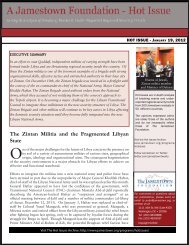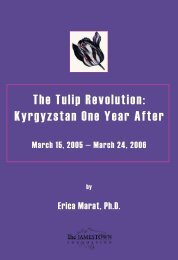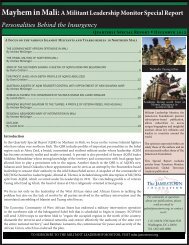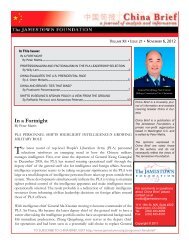By Brian Glyn Williams - The Jamestown Foundation
By Brian Glyn Williams - The Jamestown Foundation
By Brian Glyn Williams - The Jamestown Foundation
Create successful ePaper yourself
Turn your PDF publications into a flip-book with our unique Google optimized e-Paper software.
assistance in the Persian War of 1578-1590 undoubtedly contributed greatly to the Ottoman cause and may<br />
have been the deciding factor in the successful outcome of the war in the Sultan's favor. In the treaty of 1590,<br />
the Safavids ceded the provinces of Azerbaijan, Shirvan, Genje, Georgia and parts of Kurdistan to the<br />
victorious Ottomans.<br />
<strong>The</strong> Ottoman government's control over these districts in the Caucasus proved to be very short lived,<br />
however; and, in 1603, Shah Abbas the Great led a newly unified Persia on a reconquest of its lost<br />
provinces. <strong>The</strong> Tatars appear to have assisted the Ottomans in their defensive struggle against the Shah<br />
according to John Malcolm who mentions the defeat of the Turks and their allies the "Tatars of the<br />
Kapchak." 34 Despite this assistance, the Ottomans had lost control over most of their hard-won<br />
conquests by 1612.<br />
<strong>The</strong> Ottomans were able to maintain control over a small remnant of their conquests in Dagestan up until<br />
the mid-seventeenth century only with the assistance of the Tatar Khans. <strong>The</strong> Ottomans continued to supply<br />
this eastern region by using the Kuban steppe. <strong>The</strong> route from the Crimean port of Kaffa to Tamman<br />
(western Caucasus) and across Kuban to Derbent (eastern Caucasus) was the only route open to the Eastern<br />
Caucasus after Shah Abbas' conquest of Georgia, Armenia and Karabagh had effectively cut off the<br />
Ottomans' southern supply lines. <strong>The</strong> Circassians and Nogay tribes who roamed over the steppe were<br />
kept in check by the Crimean Khan whose right to exert authority over the area had been previously<br />
recognized by the Ottoman Sultan. 35<br />
<strong>The</strong> Tatars also continued to assist the Ottomans in their campaigns into Safavid territory, and they could be<br />
found participating in several lesser campaigns in the Caucasus in 1618, 1635 and 1639. It was not,<br />
however, until 1725, that they again made a major contribution to the Ottoman cause on the Persian front.<br />
An analysis of this campaign will demonstrate the effectiveness of the Tatars even at this late date.<br />
In 1722, the Safavid dynasty collapsed before the onslaught of an Afghan army, and the Ottoman<br />
government considered the time once again ripe for expansion in the Caucasus. <strong>The</strong> Porte also had the<br />
alternate motive of halting the Russians who were taking advantage of Persia's weakness and advancing down<br />
the eastern coast of the Caucasus in the Derbent region. <strong>The</strong> death of Peter the Great in 1725 brought a halt to the<br />
Russian expansion southward, but the Ottoman advance continued with surprising success. <strong>By</strong> 1727,<br />
Yerevan, Ganja, Nakhichevan, Marand, Urmiyah and most of Azerbaijan, including Tabriz, had come<br />
under Ottoman control.<br />
<strong>The</strong> Porte's control over this region proved to once again be ephemeral, and with the emergence of a<br />
newly unified Persia under Nadir Shah, the Ottomans were again forced on the defensive. From 1730<br />
to 1735, Nadir Shah fought, with varying degrees of success, against the Ottomans for control of the<br />
Caucasus and Kurdistan.<br />
In describing Nadir Shah's newly vitalized forces, V.J. Parry states "Without a doubt it was the most<br />
powerful army in western Asia during the eighteenth century." 36 <strong>The</strong> Ottoman commander assigned to defend<br />
the Sultan's new possessions against this formidable opponent, Topal Osman, felt it essential to call on the<br />
Crimean Tatars for assistance.<br />
<strong>The</strong> Khan at that time, Kaplan Giray, responded by sending a distractionary expedition into the Caucasus<br />
under the leadership of the Kalgay, Fetih Giray. Fetih Giray began the campaign off by leading a force of<br />
Crimean Tatars, Circassians and Nogays across the Kuban where they received the submission of several<br />
12
















